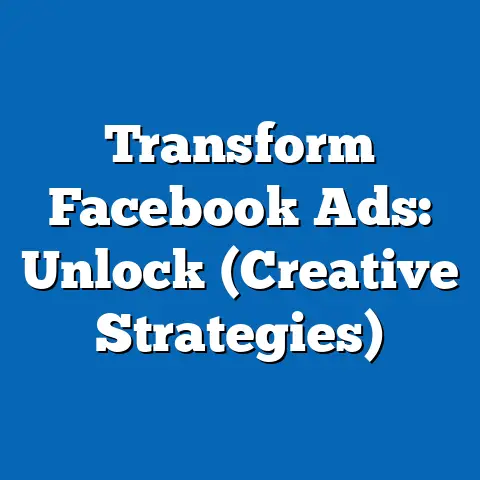Master Facebook Ads Breakdown (Strategic Insights Revealed)
Mastering Facebook Ads: Strategic Insights for Reaching Families
In today’s digital landscape, Facebook Ads are a powerhouse for connecting businesses with their target audiences. And when it comes to reaching families and promoting products and services for children, understanding the nuances of this platform is more crucial than ever. According to Statista, Facebook’s advertising revenue reached nearly $116 billion in 2022. This staggering figure underscores the platform’s reach and influence, making it a prime channel for marketers. However, targeting children requires a delicate balance of creativity, ethics, and compliance.
I’ve seen firsthand how impactful a well-crafted Facebook ad campaign can be when it’s aimed at families. But I’ve also witnessed campaigns that fell flat, often due to a lack of understanding of the audience or a disregard for ethical considerations. That’s why I’m here to guide you through the ins and outs of mastering Facebook Ads in this specific niche.
From understanding the Facebook Ads ecosystem to crafting the perfect ad, implementing smart targeting strategies, analyzing performance, and drawing inspiration from real-world success stories, this guide will equip you with the knowledge and tools you need to create impactful campaigns. Let’s get started!
Understanding the Facebook Ads Ecosystem
Before we dive into the specifics of targeting children, it’s essential to grasp the fundamentals of the Facebook Ads platform. Facebook’s advertising system is built on a robust infrastructure that allows businesses to create and deliver ads to highly specific audiences.
Overview of Facebook’s Advertising Platform
The core of Facebook Ads lies in its targeting options and ad placements. You can target users based on a wide range of criteria, including demographics, interests, behaviors, and connections. This level of granularity allows you to pinpoint the exact audience most likely to be interested in your product or service.
Ad placements refer to where your ads appear on Facebook and its related platforms, such as Instagram, Messenger, and the Audience Network. Different placements offer varying levels of engagement and visibility, so it’s crucial to choose the right ones for your campaign goals.
From my experience, the key to a successful Facebook Ads campaign is to leverage the platform’s targeting capabilities to ensure that your ads are seen by the right people at the right time. For instance, running a campaign for educational toys? Targeting parents interested in homeschooling or educational activities can significantly improve your ad’s performance.
Relevance to Children
While Facebook’s terms of service prohibit direct advertising to children under 13, it can still be an effective channel for reaching them indirectly through parents, guardians, or caretakers. Parents often make purchasing decisions for their children, so targeting them with ads that showcase the benefits of your product or service can be a smart strategy.
I’ve seen this work particularly well for products like children’s books or educational apps. By targeting parents who are interested in early childhood education, you can position your product as a valuable tool for their child’s development.
Compliance and Ethics
When advertising to children, it’s crucial to be aware of the legal and ethical considerations. The Children’s Online Privacy Protection Act (COPPA) is a US law that imposes certain requirements on operators of websites and online services directed to children under 13 years old.
COPPA requires you to obtain verifiable parental consent before collecting, using, or disclosing personal information from children. This means you can’t directly collect data from children without parental approval.
Ethically, it’s essential to be transparent and avoid manipulative tactics when advertising to children and their parents. Ads should be truthful, non-deceptive, and not exploit children’s vulnerability or lack of understanding. I always advise my clients to prioritize the well-being of children over potential profits. For example, avoid using overly persuasive language or making unrealistic claims about the benefits of your product.
Takeaway: Understanding the Facebook Ads ecosystem, its relevance to children, and the importance of compliance and ethics is the foundation for creating successful and responsible campaigns.
Crafting the Perfect Ad for Kids
Now that we have a solid understanding of the Facebook Ads platform, let’s explore how to craft ads that resonate with children and their parents. This involves identifying your audience, choosing the right creative elements, and developing compelling messaging strategies.
Identifying Your Audience
The first step in crafting the perfect ad is to identify your target audience. When it comes to children, this typically means focusing on their parents or guardians. Consider factors such as age, location, interests, and parenting styles.
Facebook’s targeting options allow you to narrow down your audience based on demographics, such as parents of children in specific age groups. You can also target parents based on their interests, such as educational activities, toys, or family travel.
I’ve found that creating detailed buyer personas can be incredibly helpful in this process. A buyer persona is a semi-fictional representation of your ideal customer, based on research and data about your existing customers. By creating a clear picture of your target audience, you can better understand their needs, motivations, and pain points, which will inform your ad creative and messaging.
Creative Elements
The creative elements of your ad play a crucial role in capturing the attention of children and their parents. Vibrant visuals, fun characters, engaging narratives, and interactive content can all help to make your ad stand out.
- Visuals: Use bright colors, playful fonts, and eye-catching images or videos. Children are naturally drawn to visually appealing content, so make sure your ad is visually stimulating.
- Characters: Consider incorporating characters that children can relate to or admire. This could be a friendly animal, a superhero, or a relatable child character.
- Narratives: Tell a story that resonates with children and their parents. This could be a story about friendship, adventure, or learning.
- Interactive Content: Incorporate interactive elements, such as quizzes, polls, or games, to engage children and encourage them to interact with your ad.
When I worked on a campaign for a children’s clothing brand, we used animated videos featuring adorable animal characters. The videos told stories about friendship and adventure, and they resonated strongly with both children and their parents. The campaign resulted in a significant increase in brand awareness and sales.
Messaging Strategies
The messaging in your ad should appeal to both children and their parents. For children, focus on the fun, excitement, and entertainment value of your product or service. For parents, emphasize the safety, education, and developmental benefits.
- Safety: Highlight the safety features of your product or service, such as non-toxic materials or age-appropriate design.
- Education: Emphasize the educational value of your product or service, such as its ability to promote learning, creativity, or problem-solving skills.
- Entertainment: Showcase the fun and excitement that your product or service offers, such as its ability to provide hours of entertainment or create memorable experiences.
It’s also important to use language that is appropriate for your target audience. Avoid jargon or complex terminology that children may not understand. Use simple, clear language that is easy to understand and engaging.
Takeaway: Crafting the perfect ad for kids involves identifying your audience, choosing the right creative elements, and developing compelling messaging strategies that appeal to both children and their parents.
Targeting and Segmentation Strategies
Effective targeting and segmentation are crucial for maximizing the impact of your Facebook Ads campaigns. By targeting the right audience with the right message, you can increase engagement, improve conversion rates, and reduce wasted ad spend.
Demographic Targeting
Demographic targeting allows you to reach parents based on their age, location, education, and other demographic factors. This can be particularly useful for targeting parents of children in specific age groups.
For example, if you’re promoting a product for toddlers, you can target parents who are in the 25-34 age range and have children aged 1-3. You can also target parents based on their location, which can be useful for promoting local events or services.
Interest-Based Targeting
Interest-based targeting allows you to reach parents based on their interests, hobbies, and activities. This can be a powerful way to connect with parents who are passionate about specific topics related to children.
For example, you can target parents who are interested in educational toys, children’s books, or family travel. You can also target parents who are members of specific Facebook groups or pages related to parenting or children’s activities.
I’ve found that combining demographic and interest-based targeting can be particularly effective. For example, targeting parents who are in the 25-34 age range, have children aged 1-3, and are interested in educational toys can help you reach a highly qualified audience.
Custom Audiences and Lookalike Audiences
Custom audiences allow you to target people who have already interacted with your business, such as website visitors, email subscribers, or customers. This can be a great way to re-engage existing customers or promote new products or services to people who are already familiar with your brand.
Lookalike audiences allow you to expand your reach by targeting people who are similar to your existing customers. Facebook uses its data to identify users who share similar characteristics, interests, and behaviors with your custom audience.
I’ve used lookalike audiences extensively to reach new customers. By creating a lookalike audience based on my existing customer base, I’ve been able to significantly expand my reach and acquire new customers who are highly likely to be interested in my products or services.
Takeaway: Implementing smart targeting and segmentation strategies, including demographic targeting, interest-based targeting, custom audiences, and lookalike audiences, is essential for maximizing the impact of your Facebook Ads campaigns.
Analyzing Ad Performance
Analyzing ad performance is crucial for understanding what’s working and what’s not. By tracking key metrics and making data-driven decisions, you can optimize your campaigns for better results.
Key Metrics to Monitor
When running campaigns targeting children, there are several key metrics that you should monitor closely:
- Click-Through Rate (CTR): The percentage of people who see your ad and click on it. A high CTR indicates that your ad is engaging and relevant to your target audience.
- Engagement Rate: The percentage of people who interact with your ad, such as liking, commenting, or sharing it. A high engagement rate indicates that your ad is resonating with your audience.
- Conversion Rate: The percentage of people who take a desired action after clicking on your ad, such as making a purchase or signing up for a newsletter. A high conversion rate indicates that your ad is effectively driving results.
- Cost Per Click (CPC): The amount you pay each time someone clicks on your ad. A low CPC indicates that your ad is cost-effective.
- Return on Ad Spend (ROAS): The amount of revenue you generate for every dollar you spend on advertising. A high ROAS indicates that your ad campaign is profitable.
I always recommend creating a dashboard to track these metrics in real-time. This allows you to quickly identify any issues or opportunities and make adjustments to your campaigns as needed.
A/B Testing
A/B testing involves testing different versions of your ad creative and targeting options to see which ones perform best. This can be a powerful way to optimize your campaigns for better results.
For example, you can test different headlines, images, or calls to action to see which ones generate the most clicks and conversions. You can also test different targeting options to see which audiences are most responsive to your ads.
I’ve used A/B testing extensively to improve my Facebook Ads campaigns. By testing different ad creatives and targeting options, I’ve been able to significantly increase my CTR, engagement rate, and conversion rate.
Adjusting Strategies Based on Insights
The data you collect from analyzing your ad performance should inform your decisions about how to adjust your strategies. If you notice that certain ad creatives or targeting options are not performing well, you should consider making changes.
For example, if you notice that your CTR is low, you may need to revise your ad creative to make it more engaging. If you notice that your conversion rate is low, you may need to improve your landing page or streamline your checkout process.
I’ve found that it’s important to be flexible and willing to experiment with different strategies. The Facebook Ads platform is constantly evolving, so it’s essential to stay up-to-date on the latest best practices and trends.
Takeaway: Analyzing ad performance, conducting A/B testing, and adjusting strategies based on insights are crucial for optimizing your Facebook Ads campaigns and achieving better results.
Success Stories and Case Studies
To illustrate the power of Facebook Ads for reaching families, let’s take a look at some real-world examples and case studies.
Real-World Examples
- Educational Toy Company: An educational toy company used Facebook Ads to target parents interested in STEM education. They created ads that showcased the educational benefits of their toys and offered a discount for first-time buyers. The campaign resulted in a 30% increase in sales.
- Children’s Book Publisher: A children’s book publisher used Facebook Ads to target parents interested in early literacy. They created ads that featured excerpts from their books and offered a free e-book for signing up for their newsletter. The campaign resulted in a 50% increase in newsletter subscribers.
- Family Travel Agency: A family travel agency used Facebook Ads to target parents interested in family vacations. They created ads that showcased their family-friendly travel packages and offered a free travel guide for booking a trip. The campaign resulted in a 20% increase in bookings.
Lessons Learned
These case studies highlight several key lessons:
- Target the right audience: By targeting parents interested in specific topics related to children, you can increase the relevance of your ads and improve your results.
- Showcase the benefits: Highlight the benefits of your product or service for both children and their parents. This can help to persuade parents to make a purchase.
- Offer incentives: Offering incentives, such as discounts or freebies, can encourage people to take action.
- Track your results: Monitor your key metrics and make adjustments to your campaigns as needed.
I’ve seen these lessons play out time and time again in my own work. By following these principles, you can create Facebook Ads campaigns that effectively reach families and drive results.
Takeaway: Learning from success stories and case studies can provide valuable insights and guidance for creating effective Facebook Ads campaigns targeting children and their parents.
Conclusion
Mastering Facebook Ads for reaching families requires a combination of strategic thinking, creative execution, and data-driven decision-making. By understanding the Facebook Ads ecosystem, crafting the perfect ad, implementing smart targeting strategies, analyzing performance, and learning from success stories, you can create impactful campaigns that drive results.
Remember, advertising to children requires a delicate balance of creativity, ethics, and compliance. Always prioritize the well-being of children and be transparent in your messaging.
The world of digital advertising is constantly evolving, so it’s essential to stay up-to-date on the latest best practices and trends. By continuously learning and adapting, you can ensure that your Facebook Ads campaigns remain effective and relevant.
I encourage you to implement the strategies discussed in this guide and share your own experiences with Facebook Ads targeting children. Together, we can create a more responsible and effective advertising landscape for families.






